
Author: He Hao, Wall Street News
The currency circle is undergoing a round of deep adjustments.Bitcoin’s price has fallen by about 20% since its all-time high in early October.This adjustment occurred at the end of Bitcoin’s “four-year cycle”.The liquidity crisis caused by the ongoing U.S. government shutdown is exacerbating the depth and duration of the adjustment.
The historical trajectory of Bitcoin’s four-year cycle
Bitcoin’s four-year cycle theory is based on its halving mechanism.Every time 210,000 blocks are mined (about four years), the block reward received by miners is halved, thereby reducing the supply of new Bitcoins.This mechanism creates predictable supply shocks that have historically triggered cyclical increases in prices.
Looking back at history, Bitcoin’s four-year cycle shows surprising regularity:
-
After the first halving in November 2012, the price of Bitcoin surged from $12 to about $1,100.
-
After the second halving in July 2016, the price increased from about $650 to nearly $20,000.
-
After the third halving in May 2020, the price climbed from approximately $8,700 to over $67,000.
-
In April 2024, Bitcoin completed its fourth halving, and the block reward dropped from 6.25 BTC to 3.125 BTC.
About a dozen months after each halving, Bitcoin will reach a cyclical high and then enter a bear market adjustment.It has been 18 months since the halving event in April 2024.
However, some research institutions have pointed out that the Bitcoin market may be gradually getting rid of the typical four-year cycle formed around “halving” in the past.Bitwise mentioned in its long-term Bitcoin research report that as institutional investors continue to enter the market and spot ETFs provide new demand channels, the market structure is becoming more mature and price fluctuations may no longer strictly follow the traditional four-year rhythm.
At the same time, the impact of this round of halving in 2024 on the supply side has been significantly weakened compared to the early stage.According to data from Glassnode and Galaxy Research, this halving has reduced the annual issuance rate of Bitcoin from approximately 1.7% to approximately 0.85%. However, since approximately 19.7 million Bitcoins have been mined (a total of 21 million), the number of new issuances accounts for a very limited proportion of the overall stock, and its marginal impact on the market is diminishing.This means that market pricing will be more dependent on the structure of capital inflows (especially institutions and long-term holders), and will no longer be mainly driven by changes in new supply.
“Whale” Selling: Typical of the End of the Cycle
Citi’s latest report reveals the key driver behind the current correction: on-chain data shows that Bitcoin “whales” (large holders) are gradually decreasing, while holdings in small “retail” wallets are increasing.This phenomenon is highly consistent with the four-year cycle theory, that is, at the end of the cycle, smart money usually sells Bitcoin to new entrants.
On-chain data shows that since August, whales have sold a total of 147,000 Bitcoins, worth approximately US$16 billion.
Citi pointed out in the report that the number of addresses holding more than 1,000 Bitcoins is declining, while the number of “retail” investors holding less than 1 Bitcoin is increasing.Glassnode’s stratified analysis of currency holdings shows that entities holding more than 10,000 Bitcoins are in a clear “distribution” stage, while the group holding 1,000-10,000 Bitcoins is generally more neutral, and net purchases mainly come from investor groups with smaller currency holdings and a tendency to long-term allocation.

There is a deep logic behind this selling pattern.Almost all long-term holders are currently in the black and are undergoing massive profit-taking.André Dragosch, Bitwise’s European research director, pointed out that these whales “believe in the four-year halving cycle and therefore expect that Bitcoin has reached the peak of this cycle.”
CryptoQuant CEO Ki Young Ju pointed out that the market structure of this round is different from the past “whales selling to retail investors” and is evolving into “old whales transferring chips to new long-term holders (such as institutions, ETFs and allocation buyers)”.This means that while selling pressure is still occurring, the nature of the takers is changing and price corrections may therefore appear to be milder but longer lasting.
Government shutdown’s liquidity pump
The more direct catalyst for the current Bitcoin adjustment comes from the liquidity crisis caused by the U.S. government shutdown.The sharp expansion of the balance of the U.S. Treasury General Account (TGA) is draining a large amount of liquidity from the market, and Bitcoin, as a risk asset, is bearing the brunt.
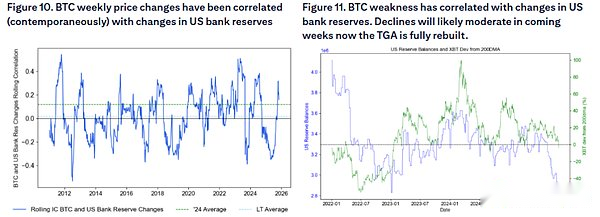
At the end of October 2025, the TGA balance exceeded US$1 trillion for the first time, setting a new high in the past five years since April 2021.Over the past few months, TGA balances have surged from about $300 billion to $1 trillion, draining more than $700 billion of liquidity from the market.
It needs to be clear that the increase in TGA balance is not caused only by the government shutdown, but the superimposed effect of two factors:
-
The first is the government shutdown itself: Since the government shutdown on October 1, 2025, the U.S. Treasury Department is still collecting funds through taxation and bond issuance, but because Congress has not approved the budget and most government departments are closed, the U.S. Treasury Department cannot spend as planned, and TGA is therefore “only in but not out.”
-
The second is the continuing impact of large-scale issuance of U.S. debt.Even during normal government operations, the U.S. Treasury Department will replenish the TGA account through debt issuance, which will also drain liquidity from the market.
The impact of this “double pumping” mechanism is huge:
According to official reports from the Federal Reserve and data from financial institutions, cash assets of foreign commercial banks have fallen to approximately US$1.176 trillion, a significant decrease from the peak in July.The Federal Reserve’s total reserves fell to $2.8 trillion, the lowest level since early 2021.
The expansion of TGA balances triggered overall tension in the currency market.The high end of the overnight repurchase rate once reached 4.27%, which is much higher than the Fed’s excess reserve interest rate of 3.9% and the federal funds target range of 3.75%-4.00%.The SOFR interest rate also moved significantly higher, indicating that market liquidity has tightened significantly.
The Citi report specifically emphasized that cryptocurrencies are “very sensitive” to bank liquidity conditions.Research shows that Bitcoin’s weekly price changes show a simultaneous correlation with changes in U.S. bank reserves, with declines in bank reserves often accompanied by Bitcoin’s weak performance.This sensitivity makes Bitcoin the earliest and most sensitive victim of liquidity tightening.
From the perspective of policy effects, the government shutdown is equivalent to implementing multiple rounds of disguised interest rate hikes.Analysts believe that the tightening effect of the $700 billion in liquidity that the U.S. Treasury Department has withdrawn from the market is comparable to a significant tightening of monetary policy.
The Federal Reserve announced the end of quantitative tightening (QT) at its October meeting. Analysis pointed out that if it were not for liquidity constraints, the Federal Reserve may not announce the end of quantitative tightening.However, this operation by the Fed will not begin until December.
The October 10th “Black Friday” liquidation event
Citi pointed out in the report that the “Black Friday” liquidation event on October 10 further damaged the market’s risk appetite.While futures markets are typically a zero-sum game, this liquidation may have hurt the risk-taking capabilities of crypto natives and dampened the risk appetite of new potential ETF investors.
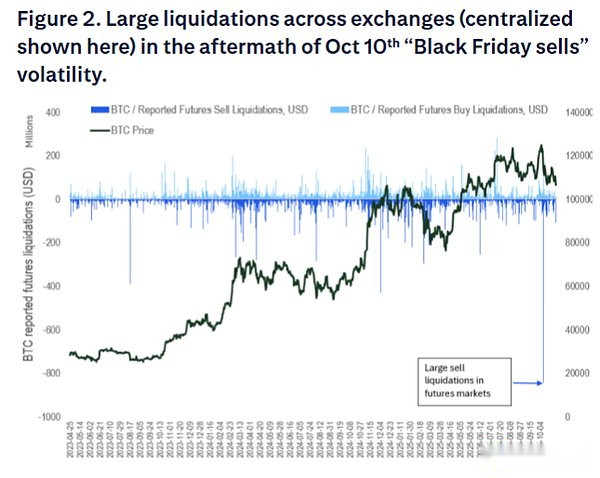
The decline in funding rates also reflects a lack of demand for leverage, indicating overall weakness in market sentiment.
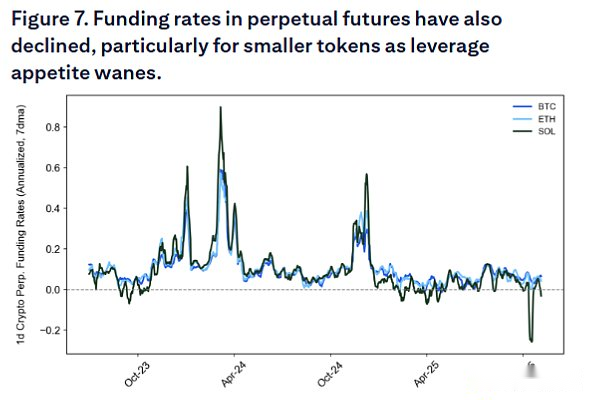
In addition, U.S. spot Bitcoin ETF inflows have decreased significantly over the past few weeks, which was contrary to market expectations, as ETF flows were considered relatively immune to the October 10 “Black Friday” liquidations of futures and decentralized exchanges.Inflows into Ethereum ETFs have also slowed significantly.
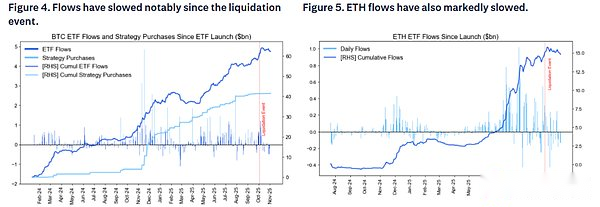
The Citi report also noted that Bitcoin is currently trading below its 200-day moving average, which typically further dampens demand.Technical analysis shows that even simple moving average rules have helped manage Bitcoin investments over the past decade, highlighting the importance of technical indicators in investment strategies.
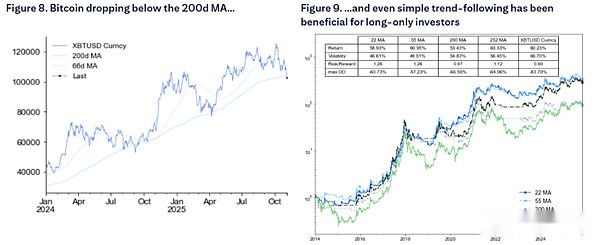
A turning point in the crisis: Liquidity release after government reopening
While the current situation is grim, the root causes of the crisis also hold the key to a potential turnaround in the market.Since the government shutdown is the main driver of liquidity tightening, once the shutdown ends, the U.S. Treasury will begin to consume its huge TGA cash balance and release hundreds of billions of dollars of liquidity into the economy.
Goldman Sachs had previously predicted that the government shutdown would most likely end around the second week of November, with key pressure points including air traffic control and airport security staff salaries expiring on October 28 and November 10 – similar disruptions in 2019 ultimately contributed to the end of the shutdown at that time.Prediction markets show that the probability of the government reopening before mid-November is about 50%, and the probability of delaying Thanksgiving is less than 20%.
Once the U.S. government reopens, the release of pent-up liquidity could trigger a massive rush for risky assets.This liquidity release may amount to “stealth quantitative easing,” a similar scenario that played out in early 2021, when the accelerated consumption of the U.S. Treasury’s cash balance drove a sharp rise in the stock market.Once the government reopens, the release of the backlog of liquidity coincides with the end of the year, which may promote a catapult rise in liquidity-sensitive assets such as Bitcoin, small-cap stocks, and almost all non-AI assets.
The worse things get in the near term, the more reserve liquidity will be released in the medium term.The current TGA balance is close to US$1 trillion. Once it starts to be consumed, the scale of liquidity released will be unprecedented.This sudden return of liquidity could be the catalyst for a strong rebound in risk assets such as Bitcoin.






